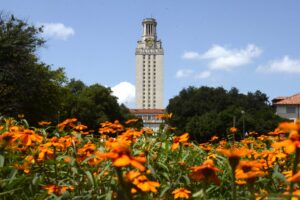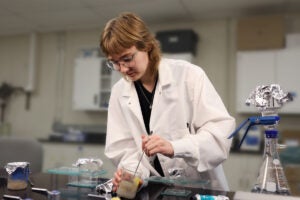The Center for American History at The University of Texas at Austin will be named for Dolph Briscoe, former governor of Texas, following gifts totaling $15 million.
The naming of the “Dolph Briscoe Center for American History” recognizes his support for preserving and promoting Texas and U.S. history. The gift is the largest in the history of the Center, and follows Briscoe’s previous financial and in-kind support for the Center’s programs and collections.
Watch video of the Dec. 1 press conference announcing the naming of the Dolph Briscoe Center for American History. (Video opens in a new window.)
“It is especially fitting that the Center be named for one of the most ardent champions of the history of Texas and our nation,” said William Powers Jr., president of The University of Texas at Austin. “Governor Briscoe’s efforts on behalf of the university are well known, particularly his support of the Center for American History. This gift allows us to significantly expand the Center’s programs and resources, not only here in Austin but across the state of Texas. We are all grateful for his generosity and continuing support.”
“The University of Texas at Austin is one of the great universities of our country and of our world today, and I am pleased to support one of its most valuable resources,” Briscoe said. “My hope is that this gift will allow the Center to not only continue, but greatly expand, its efforts on behalf of the cause of history. I have always believed that knowing and appreciating history can make a big difference for the future of our state and the future of our country.”
“This gift is truly transformational for the Center, and will have an impact on every level of our operations, ” said Dr. Don E. Carleton, executive director of the Center. “Governor Briscoe has long been our greatest ally in our efforts to be an outstanding scholarly resource for the study of Texas and United States history. I cannot thank Governor Briscoe enough for his generosity.”
Briscoe’s $15 million gift was announced by Powers as the lead gift in the public phase of fund raising in the university’s $3 billion Campaign for Texas.
Briscoe has a deep interest in American history. He donated his personal and gubernatorial papers to the Center, and serves on its Advisory Council. He played a key role in making the John Nance Garner Museum in Uvalde, Texas, a division of the Center. Briscoe’s financial support also made it possible for the Center to publish the memoir of Ross Sterling, the founder of the Humble Oil Company and a former governor of Texas. Briscoe has also supported the acquisition of key items for the Center’s collections, including an 1849 daguerreotype of the Alamo chapel, the oldest datable photograph taken in Texas. In 2007, the former governor established the Dolph and Janey Briscoe Fund for Texas History. The Center recently published his memoir, “Dolph Briscoe: My Life in Texas Ranching and Politics.”
Born in Uvalde, Texas, Briscoe graduated from the University of Texas in 1942, and enlisted in the U.S. Army during World War II. He married Betty Jane “Janey” Slaughter in 1942. He was a member of the state legislature from 1949 until 1957, when he returned to Uvalde, becoming one of the state’s leading ranchers and president of the Texas and Southwestern Cattle Raisers Association. At a time when Texans were losing faith in elected officials due to corruption and scandals, Briscoe was seen as a welcome political outsider with a conservative Democratic agenda that would bring stability to Texas government. He was elected governor in 1972 and served through the oil-boom years of the 1970s, during which he increased spending for highway improvements, signed into law the Texas Open Records Act and streamlined state agencies. Janey Briscoe was a regent of the University of Texas System from 1981 until 1987.
As one of the nation’s leading history research centers, the Center collects, preserves and makes available documentary and material culture evidence encompassing key themes in Texas and U.S. history. Researchers, students and the public mine its collections for a wide range of academic, professional and personal uses. The Center’s collections also inspire its own projects, including books, exhibits, programs, films and educational materials.



